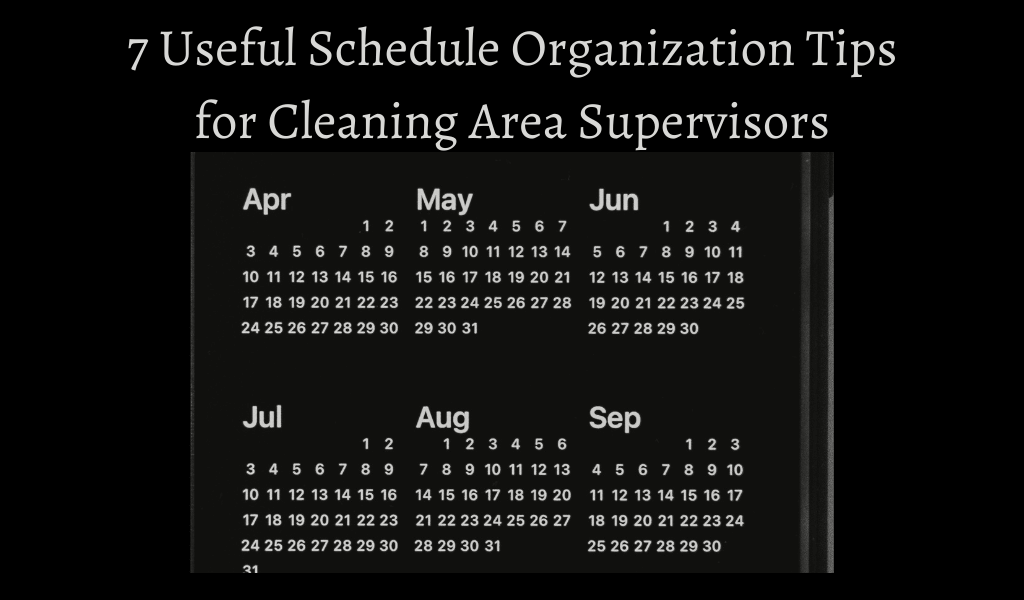One of the most challenging business puzzles to solve is scheduling, but with the right schedule organization tips, you might even enjoy the process.
You read that right. We’re saying you might enjoy putting together your team’s schedule. Even with vacations, days off, working short-staffed, or adding extra services for a client, some helpful schedule organization tips can make the process a breeze.
That’s not to say it won’t take some work. We all know a perfect schedule is still at the mercy of the fates, and anything from power outages to equipment breakdowns to injuries can throw a wrench into the gears. But the more organized and thoughtful your schedule is, the easier it is to deal with these unexpected events.
How do you reach that holy grail of a schedule? Where does this mythical creature come from? Try these schedule organization tips to capture the magic.
Keep track of inventory, work orders, and more with Janitorial Manager. Learn more today with a free discovery call!
7 Commercial cleaning schedule organization tips you can start using right now
1. Use Mobile-Friendly Scheduling Software. When it comes to schedule organization tips, you have to start here. If you don’t have an easy way to access your schedule from anywhere, then you’re working at a significant disadvantage. You may not be at the office when you have to make a schedule change or figure out who can take care of a last-minute customer request.
2. Plan Your Route Efficiently. If your team is going to multiple locations in a shift, try to group them together and in a logical order. For example, if you have several customers in Neighborhood A, do what you can to schedule them one after the other. As much as possible, schedule your clients so your team can either work their way out from the office or go to the furthest location and work their way back in. Even better, make the route a circle if you can. This is good for your schedule, but it also saves gas and wear and tear on vehicles.
3. Keep Your Schedule Steady. This could be one of the most essential schedule organization tips you read here. Outside of unforeseen events, there is no reason to ask employees to work on-call or cancel shifts at the last minute. Nor is there often a good reason to change people’s schedules from week to week. Just like you need employees to do the work you’ve promised your clients, they need you to provide stability in their schedule and paycheck. Steady shifts can improve a team’s efficiency, create a positive work environment, and reduce turnover. It also makes scheduling a heck of a lot easier.
4. Hire An On-Call Employee. This may sound like a contradiction to keeping a steady schedule, but it’s helpful to have someone who can be on call, whether it’s a contractor or an employee. While most of your team has a regular schedule, an on-call employee can fill in gaps when someone is out sick or takes a day off. And there’s a good chance that if you look around, you’ll find someone who wants this type of job situation. It’s a few extra bucks for them on occasion without the commitment of a full schedule. As long as the two of you are very clear about the arrangement, this can be an extremely helpful way to get out of a scheduling crunch. By the way, you can also ask your current staff if anyone is interested in being on call in addition to their regular schedule.
5. Create A System For Time Off. One of the toughest things about a steady schedule is planning for time off. There are a few ways you can handle this. People can swap shifts as long as a manager approves the swap. You can also require people to ask for time off at least one or two weeks in advance; then, you can fill in the space in the schedule. Either option can work, and in fact, both of these working in conjunction can make scheduling easier on everybody all the way around. To be clear, these systems are for planned time off. If someone is out because of an emergency, reach out to your on-call or flexible employees to pick up that shift.
6. Build In Time For Training. From training new employees to veteran employees learning new skills or earning certifications, you’ll always need to find time for additional “outside” activities. While this might not seem like one of the more helpful schedule organization tips, you have to look at the big picture here. The more people you have fully trained or certified for certain tasks, the more flexibility you have with your schedule. For example, if you only have one person certified to care for marble floors, then you’re in a bind if that person is sick or needs a vacation. However, if you have several people on your team with this certification, you can mix and match as needed.
7. Build Goodwill. What does this have to do with scheduling? Like many aspects of a commercial cleaning business, scheduling is easier when your team and you have a good working relationship. When you create a great work environment and take care of your team, they are more willing to work with you to fill in gaps, take that extra shift, be gracious about unexpected changes, and go out of their way to help you out.
The good news is that you don’t have to take on the challenge by yourself. High-quality janitorial management software (like Janitorial Manager!) comes with scheduling and communication tools to make everything you do easier, more efficient, and more accurate.
Harness the value of Janitorial Manager to advance your business like never before. Learn more today with a free discovery call and find out how to make your cleaning business more efficient and more profitable!


